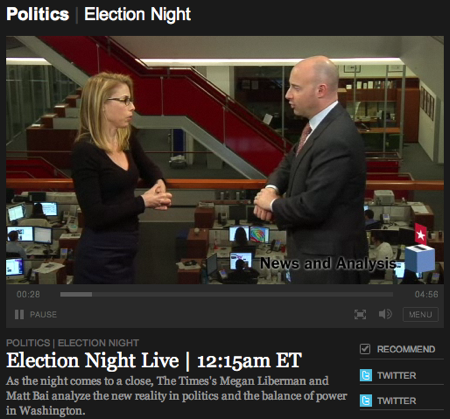
If the 2008 election coverage was a coming-out party for social media, then last night was to some extent a party for live-streamed video. On news sites large and small, national and local, the red-and-blue infographics you’d expect to see stretched across homepages were often broken up by boxes of straight-from-the-newsroom, live presentations by reporters. Two biggies in that group came from two biggies in online news: The New York Times, building off of its TimesCasts experience, offered an occasional, from-the-newsroom live-stream — a first for the paper — while the Wall Street Journal, building off its daily NewsHub video, featured a constant, six-hour-long event.
Both “broadcasts” had a Wayne’s World-but-in-suits feel to them: fairly casual, conversation-oriented, and, most of all, markedly lo-fi in setting and aesthetics — a kind of cable-access-channel-like response to the ZOOM! POW! PLEASEPLEASEPLEASEDONTCHANGETHECHANNEL! pizzazz of cable news proper. It was a bit of a back-to-the-future move for news organizations that largely marketed last night’s coverage not in terms not of personality — “let Dan Rather guide you through election returns” — but of platform: “We have X graphic!” “Tune in for X interactive!” On cable channels, the anchors and reporters and news analysts and commentators were often framed not merely as authorities in their own right, but also as hosts for a pageant-like parade of pretty new technologies. (Check out CNN’s awesome new Hologram Wall! And, oh yeah, some reporter.)
The video feeds suggested a reverse of that: On the webcasts, technology became the conduit for the personality. The video brought bylines to life (so that’s what Jim Rutenberg looks like!); it humanized the otherwise extra-personal data and narrative that pinged around the papers’ sites last night. And while there’s something to be said for the lean-back experience of effortless immersion that is watching election results, as opposed to reading about them or hearing about them, online — for news audiences, passivity itself can be a selling point for content — it’s an open question how much room the web has for such straight-from-cable thinking when it comes to the content that lives on it. Which is to say, the content that’s created for it.
Last night’s webcasts, as informal as they felt, also had the feeling of trying to be cable news without actually, you know, being cable news: They took the mores of the visual medium — analysis, punctuated by banter, interrupted by breaking news — and adopted them. Instead of adapting them. The attempts to bring a new dimension to election coverage was certainly admirable, as most experimentation generally is. But they also begged an open question: With the web’s increasing ability to act like television…how much should it act like television? Why try to out-TV TV?